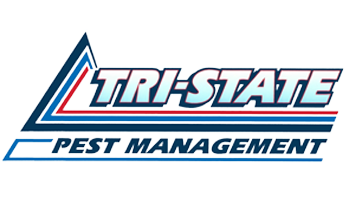LOCALLY OWNED AND SAFELY SERVING DE, PA AND MD SINCE 1987
Call now for a fast and free estimate. Proudly offering Senior and Veteran discounts.
Call Now 1-800-827-0512
Pest Library
You may use the following information to try to identify the pest that’s bothering you. Move your cursor over each image on the page to see more information about each pest. Along with a photo, you’ll find the average size and some particular characteristics.
Once you have identified the pest, or if you can’t identify the pest in your home or business, give us a call and we will provide you with a fast free estimate and the best option for pest treatment and prevention.
American Cockroach

1 3/8" - 2 1/8"
Mostly light brown in color, this pest is the largest of the cockroaches in the United States, and is found in restaurants, bakeries, and larger commercial buildings involved in food processing. In homes, the American cockroach enters in search of moisture and food. Therefore, it comes to no surprise they usually infest food storage and preparation areas. Like many pests, the American cockroach produces an unpleasant odor, especially as an infestation worsens.
House Cricket
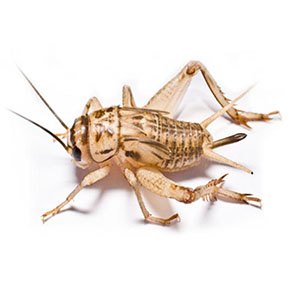
3/4" - 7/8"
Found throughout the United States.
Crickets are nocturnal and usually hide in dark, warm places during the day. The familiar chirping sound is created by the male rubbing his front wings together. This is his mating call. Crickets seek moisture and tend to damage clothing by eating out large areas of the fabrics.
German Cockroaches
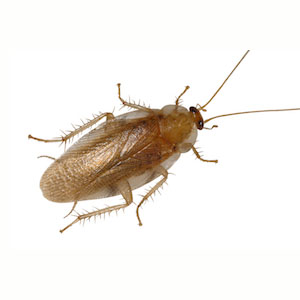
1/2" - 5/8"
This is the most common of the cockroaches. Color is a light brown to tan except for two dark stripes on its upper back. It is not only a nuisance, it has been implicated in outbreaks of illnesses, and has caused allergenic reactions in many people.
Oriental Cockroach
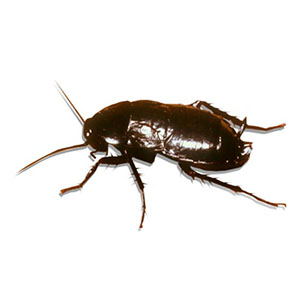
1" - 1 1/4"
Color is usually shiny black, but may vary to a dark, reddish brown.
They typically enter buildings via door thresholds, utility pipes, and floor drains. Often found in crawl spaces, basements, and on 1st floors, they are despised for their strong, roachy odor.
Ground Beetle
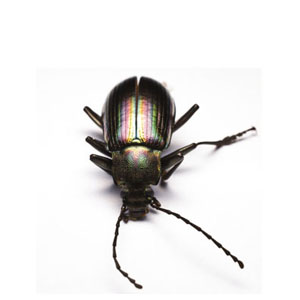
1/16" - 1 3/8"
Color is almost uniformly black and shiny. Often found under stone during the day, a few species even climb trees in search of food. They are a nuisance pest and give off a very unpleasant odor when handled or crushed.
Earwig

1/4" - 1"
The name comes from an old european superstition that these insects enter the ears of sleeping people and bore into the brain. They exist worldwide. Color varies from pale brown with dark markings to uniformly reddish brown to black, but with paler legs. They have a repugnant odor which is released when they are crushed. They are a pest in flour mills, meat packing plants, homes, and nurseries.
Black Carpet Beetle

1/8" - 1/4"
Color is dull dark brown to black. Found throughout the United States but most commonly in the northeast. As named, they tend to attack carpeting, drapery, clothes, furs, fabric-covered furniture, and stored products, even food products such as flour and cereals.
Box Elder Bug
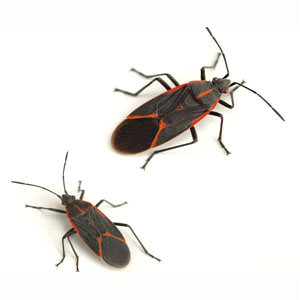
1/2"
As the name reflects, this is a major pest of box Elder trees. Color is black with reddish lines on the dorsum. They are a nuisance pest because they enter structures to live through the winter weather. They may leave a red stain behind on curtains, clothing, and drapes. They can also bite, producing a red welt.
Deer Ticks
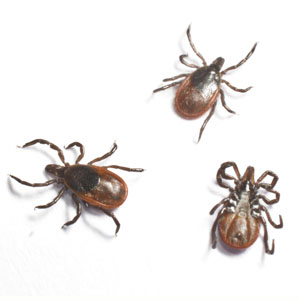
1/16" - 1/8"
Color is orang-ish brown except for the legs, which are typically dark. The adults attach themselves to passing deer, whence comes their name. They carry the Spirochaete for Lyme disease in humans in the northeast and Midwest.
House Spider
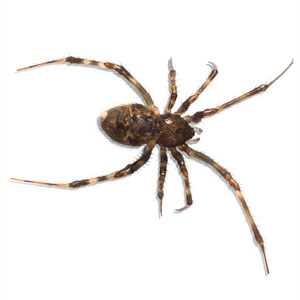
3/16" - 5/16"
This is the spider most commonly encountered inside the house, the one that made all those webs. Their color is variable, running from a dirty white to brown, It randomly selects its web sites while looking for prey and, consequently, the webs can be found most anywhere.
Brown Dog Ticks
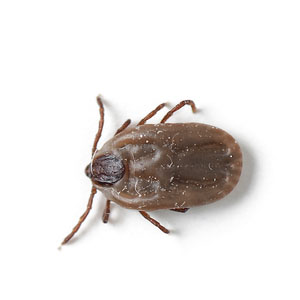
1/8"
When engorged with blood, usually from dogs, these ticks increase in size up to 1/2\". These pests are almost always associated with dogs but have been termed as vectors for Rocky Mountain Spotted Fever and several other diseases.
Reproductive Termite
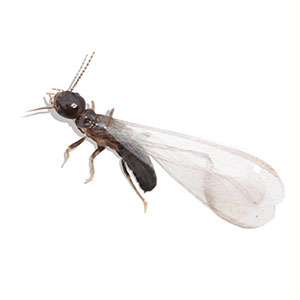
3/8"
This is the \"swarmer\" of the Eastern Subterranean Termite colony. Their color is usually black but may be a slightly lighter brown. Note that it has four wings, all of the same length, which helps to distinguish it from a flying ant whose underwings are shorter than those on top. Their function is to find new sites, mate, and begin new colonies. They are essentially kings and queens.
Worker Termite

1/8"
Color is almost uniformly white or cream. This is the damaging caste of the termite colony. They contain a microbe in their intestines that allows them to ingest cellulose (wood) as a nutrient. They must physically receive this attribute from the queen of the colony. They then feed on wood, and, being blind, they cannot tell your house from a tree.
Clothes Moth
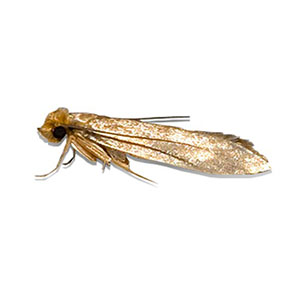
3/8" - 1/3"
Body and wings are a buff to gold, with a brownish tinge. Wings are long and narrow. As the name says, the larvae of the clothes moths infest and feed mostly on woolen clothing and furs, creating holes and voids, leaving tubes and mats with fibers and feces in them. They have also been found infesting milk products. The adults do not feed.
Silverfish
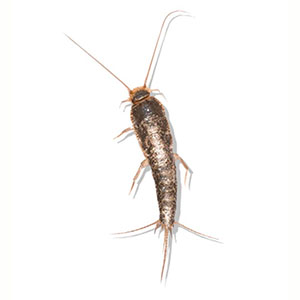
1/2" - 3/4"
Also known as a bristletail, their color is a silvery satin to gun-metal gray. They are often confused with firebrats which do not have the silvery sheen. They are mostly nocturnal and can be found in tight cracks and crevices. They are paper pests, but will also feed on any meaty protein.
Odorous House Ant
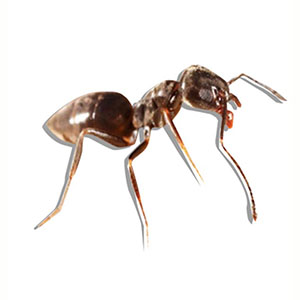
1/16" - 1/8"
Their color can be brown to black. Their name is due to the rotten odor that emanated when this ant is crushed. They can usually be found around hot water pipes and heaters, in crevices around sinks, etc. They love high protein food such as meat and cheese.
Carpenter Ant

1/8" - 1/2"
Their color is usually black but occasionally appears in a reddish brown as shown above. Unlike the termite, the carpenter ant cannot digest wood, but it will chew out galleries and hollow places to create nests, resulting in structural damage. They are sometimes evidenced by the appearance of a sawdust-like material with debris in it, including body parts, known as frass.
House Mouse
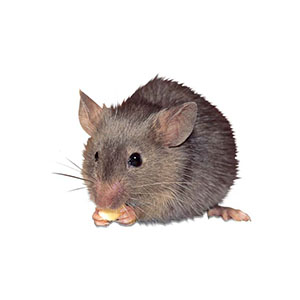
2 1/2" - 3 1/2"
Smooth, dusty gray fur usually adorns these small rodents, although color can vary considerably from place to place. They often nest in various materials such as insulation, and usually use the same pathways along walls, stacked merchandise etc. Mice prefer seeds or cereals for food. They have been known to spread salmonella disease.
Flea
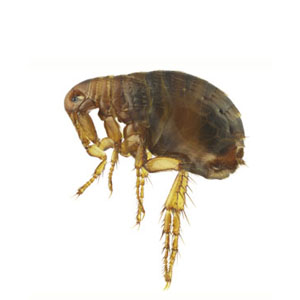
1/8"
Color is brownish black to black, but reddish black when full of blood. Fleas are known to be vectors of disease organisms causing both plague and muring typhus. They can also serve as the intermediary host for tapeworm. They are typically found where animals sleep or frequent.
Norway Rat
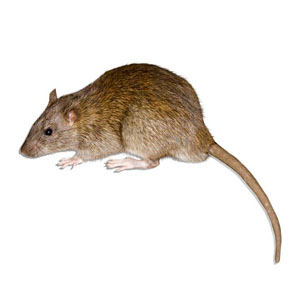
7" - 9 1/2"
The largest of the common rodents in the temperate regions of the world, it is usually a shaggy brown with scattered black hairs. The fur is coarse with the underside gray to yellowish white. It not only damages and destroys materials by gnawing, it eats and contaminates stored food, and is a carrier of many diseases.
Bed Bug
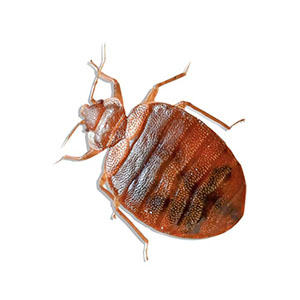
1/4"
Color is brownish. The common bed bug (Cimex lectularius Linnaeus 1758) is an ectoparisite insect (a parasite which lives on the outside of the body of the host) of the family Cimicidae. Bed bugs feed only on the blood of humans and other warm-blooded hosts. Although they have a cryptic behavior and can conceal themselves in tight cracks and crevices, bed bugs are often found in bed parts, such as mattresses and box springs, hence the common name.
Stink Bugs
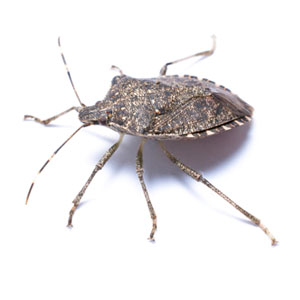
3/4"
Brown, Gray of Dark Green in color. This insect, notorious for its "smelly" reputation, earned its name from its tendency to release an odor when disturbed or when crushed. Many other insects have these same characteristics, including some species of ants, beetles and, other bugs. Most stink bugs are herbivorous and use their piercing and sucking mouthparts to feed on plant juices.
Mosquitoes
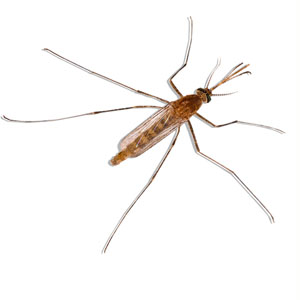
1/8"-3/4"
Can range in color from a light brown to black. This insect is known for its ability to bite mammals which typically results in itchy light pink bumps on the body. The itch that humans get as a result of a bite is actually an allergic reaction that humans have to mosquito saliva. Since mosquitoes pass from host to host, many harmful infections may be transmitted through them including Malaria, West Nile Virus, Dengue Fever, and Zika Virus. It is due to this that they are actually considered the deadliest animal family in the world.
Possum

2’
Possums are nocturnal mammals that favor secure, dark places, both below and above ground. Possums can reside in attics or under houses, porches, sheds, etc. They are usually found near homes to scavenge on garbage and other containers. Although possums are not aggressive, their large droppings can host various diseases and parasites that are dangerous to humans.
CENTIPEDE
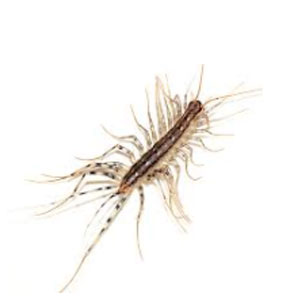
1/8”-5 ½”
As the name implies, centipedes are known for having 100 legs. However, the number of legs can vary from 40 to well over 200. Centipedes are known to prey on other pests within the household; therefore, treatment of centipedes are essential to also address the other pests within the household
European Hornets
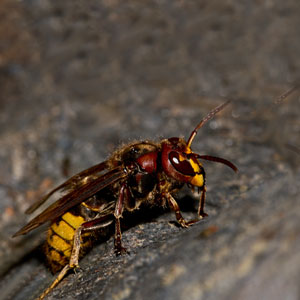
1”-1 ½”
Brown with yellow stripes on the abdomen, the European Hornet gets its name from the fact it was brought to the United States from Europe. Social in nature, European hornets commonly make their nests in holes in trees, attics, or wall voids in homes. They feed on crickets, grasshoppers, large flies, caterpillars, and the workers of other yellow jacket species. European hornets are known to sting if provoked, and should certainly be avoided.
Cicada Killers
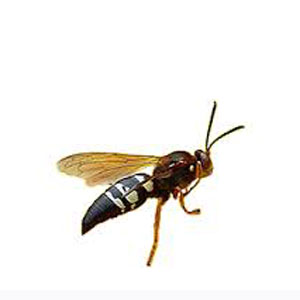
1”-2”
Black, with yellow markings on three segments, cicada killers are solitary wasps that live underground. They commonly live within close proximity to one another, and the many holes can be devastating to a yard. Adult Cicada killers feed on flower nectar and plant sap. Females are often seen carrying a paralyzed cicada, which they take back to their burrow. The female cicada killer then lays an egg on the paralyzed cicada, which hatches and uses the cicada as a nourishment source.
Carpenter Bees
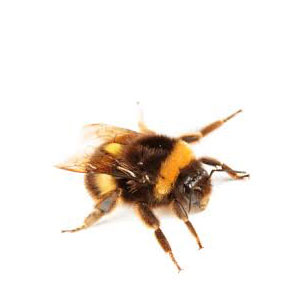
1/4”-1”
Black and yellow, or greenish black, with yellowish hairs, known for chewing a 3/8 inch tunnel into a piece of wood to build a nest gallery, the female carpenter bee takes advantage of outside wood to lay their eggs and protect their developing larvae. Although solitary in nature, carpenter bees typically nest very close to each other, and if left untreated, can cause a major problem.
Moles / Voles
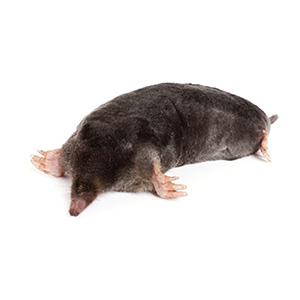
5”-7” – 5”-7 ½”
Dark brown, brown-gray, tan, or even black in appearance, moles and voles are known for leaving many shallow tunnels and runways throughout a home’s yard. Both pests are quite troublesome. While moles damage your garden while looking for insects, voles actually eat your crops, plants, and flowers.
Camel Crickets
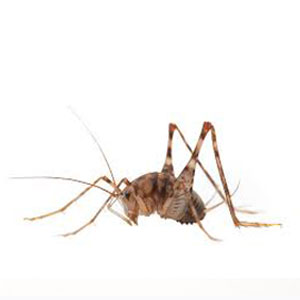
½”-2”
Brownish in color, and commonly referred to as “cave crickets” or “sprickets,” camel crickets are wingless, and rather humpbacked in appearance. In a home, they are known to eat clothes, curtains, rugs, wood, wallpaper, and wool.
Bald-Faced Hornets
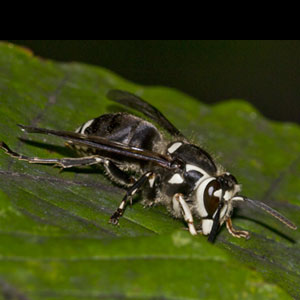
½”-3/4”
Similar to yellow jackets, but distinguishable by their white and black coloring and “bald-faced” head, Bald-faced hornets construct basketball sized nests by collecting and chewing naturally occurring fibers. They then take these fibers, and mix it with their saliva, which enables the structure to hold in place. Like yellow jackets, bald-faced hornets retain use of their stinger, and can sting their victim multiple times.
Yellow Jackets
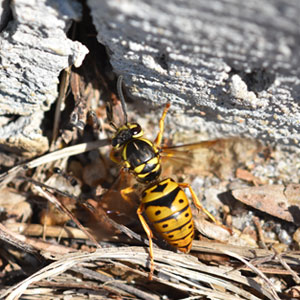
2/5”-3/5”
Yellow and black, having multiple species known for their aggressive nature, yellow jackets commonly nest in structure voids, behind siding, and even underground. Their diet primarily consists of items high in sugar and carbohydrates such as: fruits, flower nectar, and tree sap. Yellow jackets retain their stinger after use, and may sting their victim multiple times.
Paper Wasp
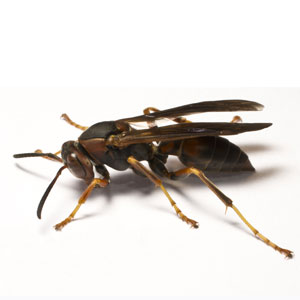
¾”-1”
Mostly dark brown in color, with black wings, and yellow markings, the paper wasp obtains their name from the construction of their nests. Paper wasps prefer to feed on nectar and pollen, and even prey on caterpillars they use to feed their colonies’ larvae.
American Cockroach

1 3/8" - 2 1/8"
Mostly light brown in color, this pest is the largest of the cockroaches in the United States, and is found in restaurants, bakeries, and larger commercial buildings involved in food processing. In homes, the American cockroach enters in search of moisture and food. Therefore, it comes to no surprise they usually infest food storage and preparation areas. Like many pests, the American cockroach produces an unpleasant odor, especially as an infestation worsens.
German Cockroaches

1/2" - 5/8"
This is the most common of the cockroaches. Color is a light brown to tan except for two dark stripes on its upper back. It is not only a nuisance, it has been implicated in outbreaks of illnesses, and has caused allergenic reactions in many people.
Oriental Cockroach

1" - 1 1/4"
Color is usually shiny black, but may vary to a dark, reddish brown.
They typically enter buildings via door thresholds, utility pipes, and floor drains. Often found in crawl spaces, basements, and on 1st floors, they are despised for their strong, roachy odor.
House Cricket

3/4" - 7/8"
Found throughout the United States.
Crickets are nocturnal and usually hide in dark, warm places during the day. The familiar chirping sound is created by the male rubbing his front wings together. This is his mating call. Crickets seek moisture and tend to damage clothing by eating out large areas of the fabrics.
Ground Beetle

1/16" - 1 3/8"
Color is almost uniformly black and shiny. Often found under stone during the day, a few species even climb trees in search of food. They are a nuisance pest and give off a very unpleasant odor when handled or crushed.
Black Carpet Beetle

1/8" - 1/4"
Color is dull dark brown to black. Found throughout the United States but most commonly in the northeast. As named, they tend to attack carpeting, drapery, clothes, furs, fabric-covered furniture, and stored products, even food products such as flour and cereals.
Earwig

1/4" - 1"
The name comes from an old european superstition that these insects enter the ears of sleeping people and bore into the brain. They exist worldwide. Color varies from pale brown with dark markings to uniformly reddish brown to black, but with paler legs. They have a repugnant odor which is released when they are crushed. They are a pest in flour mills, meat packing plants, homes, and nurseries.
Box Elder Bug

1/2"
As the name reflects, this is a major pest of box Elder trees. Color is black with reddish lines on the dorsum. They are a nuisance pest because they enter structures to live through the winter weather. They may leave a red stain behind on curtains, clothing, and drapes. They can also bite, producing a red welt.
Deer Ticks

1/16" - 1/8"
Color is orang-ish brown except for the legs, which are typically dark. The adults attach themselves to passing deer, whence comes their name. They carry the Spirochaete for Lyme disease in humans in the northeast and Midwest.
Brown Dog Ticks

1/8"
When engorged with blood, usually from dogs, these ticks increase in size up to 1/2\". These pests are almost always associated with dogs but have been termed as vectors for Rocky Mountain Spotted Fever and several other diseases.
House Spider

3/16" - 5/16"
This is the spider most commonly encountered inside the house, the one that made all those webs. Their color is variable, running from a dirty white to brown, It randomly selects its web sites while looking for prey and, consequently, the webs can be found most anywhere.
Reproductive Termite

3/8"
This is the \"swarmer\" of the Eastern Subterranean Termite colony. Their color is usually black but may be a slightly lighter brown. Note that it has four wings, all of the same length, which helps to distinguish it from a flying ant whose underwings are shorter than those on top. Their function is to find new sites, mate, and begin new colonies. They are essentially kings and queens.
Worker Termite

1/8"
Color is almost uniformly white or cream. This is the damaging caste of the termite colony. They contain a microbe in their intestines that allows them to ingest cellulose (wood) as a nutrient. They must physically receive this attribute from the queen of the colony. They then feed on wood, and, being blind, they cannot tell your house from a tree.
Silverfish

1/2" - 3/4"
Also known as a bristletail, their color is a silvery satin to gun-metal gray. They are often confused with firebrats which do not have the silvery sheen. They are mostly nocturnal and can be found in tight cracks and crevices. They are paper pests, but will also feed on any meaty protein.
Clothes Moth

3/8" - 1/3"
Body and wings are a buff to gold, with a brownish tinge. Wings are long and narrow. As the name says, the larvae of the clothes moths infest and feed mostly on woolen clothing and furs, creating holes and voids, leaving tubes and mats with fibers and feces in them. They have also been found infesting milk products. The adults do not feed.
Odorous House Ant

1/16" - 1/8"
Their color can be brown to black. Their name is due to the rotten odor that emanated when this ant is crushed. They can usually be found around hot water pipes and heaters, in crevices around sinks, etc. They love high protein food such as meat and cheese.
Carpenter Ant

1/8" - 1/2"
Their color is usually black but occasionally appears in a reddish brown as shown above. Unlike the termite, the carpenter ant cannot digest wood, but it will chew out galleries and hollow places to create nests, resulting in structural damage. They are sometimes evidenced by the appearance of a sawdust-like material with debris in it, including body parts, known as frass.
Flea

1/8"
Color is brownish black to black, but reddish black when full of blood. Fleas are known to be vectors of disease organisms causing both plague and muring typhus. They can also serve as the intermediary host for tapeworm. They are typically found where animals sleep or frequent.
House Mouse

2 1/2" - 3 1/2"
Smooth, dusty gray fur usually adorns these small rodents, although color can vary considerably from place to place. They often nest in various materials such as insulation, and usually use the same pathways along walls, stacked merchandise etc. Mice prefer seeds or cereals for food. They have been known to spread salmonella disease.
Norway Rat

7" - 9 1/2"
The largest of the common rodents in the temperate regions of the world, it is usually a shaggy brown with scattered black hairs. The fur is coarse with the underside gray to yellowish white. It not only damages and destroys materials by gnawing, it eats and contaminates stored food, and is a carrier of many diseases.
Bed Bug

1/4"
Color is brownish. The common bed bug (Cimex lectularius Linnaeus 1758) is an ectoparisite insect (a parasite which lives on the outside of the body of the host) of the family Cimicidae. Bed bugs feed only on the blood of humans and other warm-blooded hosts. Although they have a cryptic behavior and can conceal themselves in tight cracks and crevices, bed bugs are often found in bed parts, such as mattresses and box springs, hence the common name.
Stink Bugs

3/4"
Brown, Gray of Dark Green in color. This insect, notorious for its "smelly" reputation, earned its name from its tendency to release an odor when disturbed or when crushed. Many other insects have these same characteristics, including some species of ants, beetles and, other bugs. Most stink bugs are herbivorous and use their piercing and sucking mouthparts to feed on plant juices.
Possum

2’
Possums are nocturnal mammals that favor secure, dark places, both below and above ground. Possums can reside in attics or under houses, porches, sheds, etc. They are usually found near homes to scavenge on garbage and other containers. Although possums are not aggressive, their large droppings can host various diseases and parasites that are dangerous to humans.
Mosquitoes

1/8"-3/4"
Can range in color from a light brown to black. This insect is known for its ability to bite mammals which typically results in itchy light pink bumps on the body. The itch that humans get as a result of a bite is actually an allergic reaction that humans have to mosquito saliva. Since mosquitoes pass from host to host, many harmful infections may be transmitted through them including Malaria, West Nile Virus, Dengue Fever, and Zika Virus. It is due to this that they are actually considered the deadliest animal family in the world.
CENTIPEDE

1/8”-5 ½”
As the name implies, centipedes are known for having 100 legs. However, the number of legs can vary from 40 to well over 200. Centipedes are known to prey on other pests within the household; therefore, treatment of centipedes are essential to also address the other pests within the household
Camel Crickets

½”-2”
Brownish in color, and commonly referred to as “cave crickets” or “sprickets,” camel crickets are wingless, and rather humpbacked in appearance. In a home, they are known to eat clothes, curtains, rugs, wood, wallpaper, and wool.
Yellow Jackets

2/5”-3/5”
Yellow and black, having multiple species known for their aggressive nature, yellow jackets commonly nest in structure voids, behind siding, and even underground. Their diet primarily consists of items high in sugar and carbohydrates such as: fruits, flower nectar, and tree sap. Yellow jackets retain their stinger after use, and may sting their victim multiple times.
Bald-Faced Hornets

½”-3/4”
Similar to yellow jackets, but distinguishable by their white and black coloring and “bald-faced” head, Bald-faced hornets construct basketball sized nests by collecting and chewing naturally occurring fibers. They then take these fibers, and mix it with their saliva, which enables the structure to hold in place. Like yellow jackets, bald-faced hornets retain use of their stinger, and can sting their victim multiple times.
Paper Wasp

¾”-1”
Mostly dark brown in color, with black wings, and yellow markings, the paper wasp obtains their name from the construction of their nests. Paper wasps prefer to feed on nectar and pollen, and even prey on caterpillars they use to feed their colonies’ larvae.
European Hornets

1”-1 ½”
Brown with yellow stripes on the abdomen, the European Hornet gets its name from the fact it was brought to the United States from Europe. Social in nature, European hornets commonly make their nests in holes in trees, attics, or wall voids in homes. They feed on crickets, grasshoppers, large flies, caterpillars, and the workers of other yellow jacket species. European hornets are known to sting if provoked, and should certainly be avoided.
Carpenter Bees

1/4”-1”
Black and yellow, or greenish black, with yellowish hairs, known for chewing a 3/8 inch tunnel into a piece of wood to build a nest gallery, the female carpenter bee takes advantage of outside wood to lay their eggs and protect their developing larvae. Although solitary in nature, carpenter bees typically nest very close to each other, and if left untreated, can cause a major problem.
Cicada Killers

1”-2”
Black, with yellow markings on three segments, cicada killers are solitary wasps that live underground. They commonly live within close proximity to one another, and the many holes can be devastating to a yard. Adult Cicada killers feed on flower nectar and plant sap. Females are often seen carrying a paralyzed cicada, which they take back to their burrow. The female cicada killer then lays an egg on the paralyzed cicada, which hatches and uses the cicada as a nourishment source.
Moles / Voles

5”-7” – 5”-7 ½”
Dark brown, brown-gray, tan, or even black in appearance, moles and voles are known for leaving many shallow tunnels and runways throughout a home’s yard. Both pests are quite troublesome. While moles damage your garden while looking for insects, voles actually eat your crops, plants, and flowers.
Whether you were able to identify your pest(s) above, or not, give us a call. Our State Certified Technicians will be happy to identify, and treat the pest(s) for you. As a member of the National Pest Management Association with over 30 years in the business, we will address your need. Call us now!

